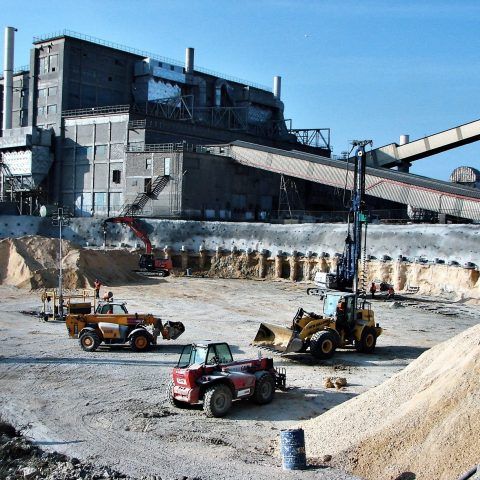Geopier Foundation Company developed the first Rammed Aggregate Pier® system as an efficient and cost-effective Intermediate Foundation® solution for the support of structures. Hundreds of bulk-storage projects around the world are supported by Geopier technologies.
Geopier RAP systems are constructed by applying direct vertical ramming energy to increase the lateral stress and improve surrounding soils. This method results in foundation settlement control and greater bearing pressures for design. The RAP system is especially effective at reinforcing good to poor soils and is appropriate for sites with very soft to stiff clay and silt, organic silt and peat, loose to dense sand, mixed soil layers, uncontrolled fill, and soil below the ground-water table. With this system the bearing pressure is increased and settlement is controlled to parameters determined by the project’s design.
Dome Technology’s work with Geopier is a coordinated effort. “We provide them with the dome size and dome loads and some layout drawings so they know what they’re supporting; they design the Geopier to fit the loading and settlement criteria,” said Dome Technology engineering project manager Adam Aagard.
Another important player is a third party providing geotechnical analysis of the site. Findings are reported to Geopier so their team knows the type of soil present and how to best improve its load-bearing capabilities. If existing soils are stiff enough and the dome and load small enough, anticipated settlement may be acceptable, in which case a conventional shallow foundation may be selected. But “oftentimes, because of the size of the dome and very heavy loads, the anticipated settlement of the existing soils may be more than would be acceptable,” said Fran Miller, Geopier’s region engineer. In that case, RAP is seriously considered as a substitute for a deep foundation system.
RAP systems do not need to extend to either dense soil or rock; instead, they are designed to create an engineered crust that increases the composite strength of the existing soil beneath the dome base slab and shallow footings where stresses will be the highest.
To install the system either a 24 to 30 inch diameter cavity is drilled or a variable-diameter mandrel is driven into the ground, displacing the soil laterally to create a cavity. The cavity is filled with multiple thin layers of crushed rock vertically rammed until densely compacted; not only does this create a very dense stiff pier, but it also improves the soil strength of the soil surrounding the pier, yielding better foundation settlement control. Licensed Geopier contractors install the system, thus providing quality control, testing, and careful adherence to drawings and specifications.
The ideal configuration—whether with tighter spacing or deeper installation—is determined based on careful analysis of the site and what the dome’s storage allowances require. “We work closely with Dome Technology to provide the amount of settlement control necessary for the dome to perform as designed and yet not drive up the overall cost of the project by providing more settlement control than necessary,” Miller said.
According to Miller, an RAP system often results in 20 to 50 percent cost savings when compared to supporting a structure on a deep-foundation system, and the construction schedule is also reduced because installation happens so quickly. Another significant advantage for heavy structures like domes is the promise of reduced differential settlement. “These large structures can often tolerate several inches of total settlement, but differential settlement needs to be reduced to reasonable amounts so the structure can perform as designed,” she said.

